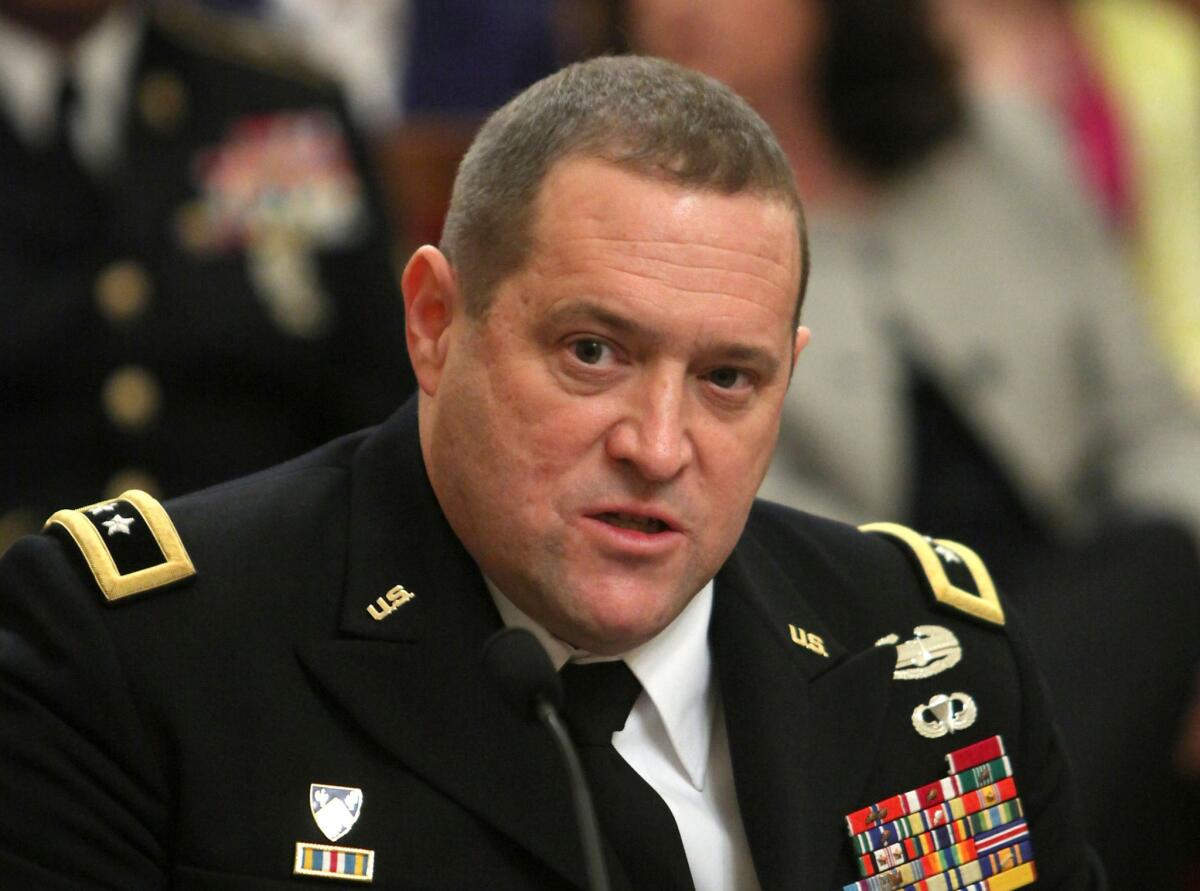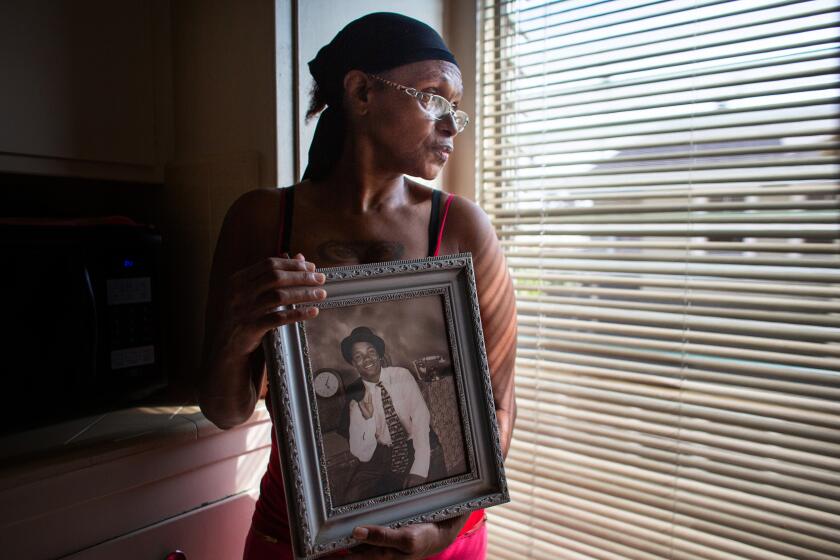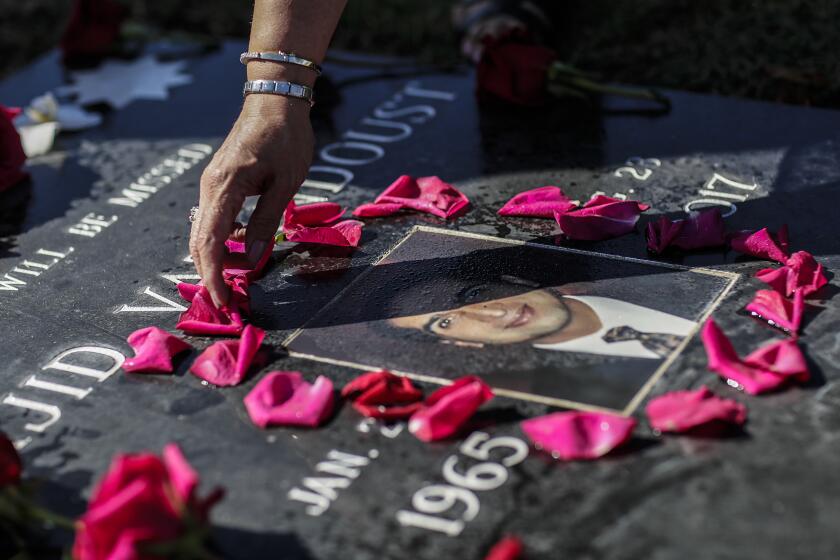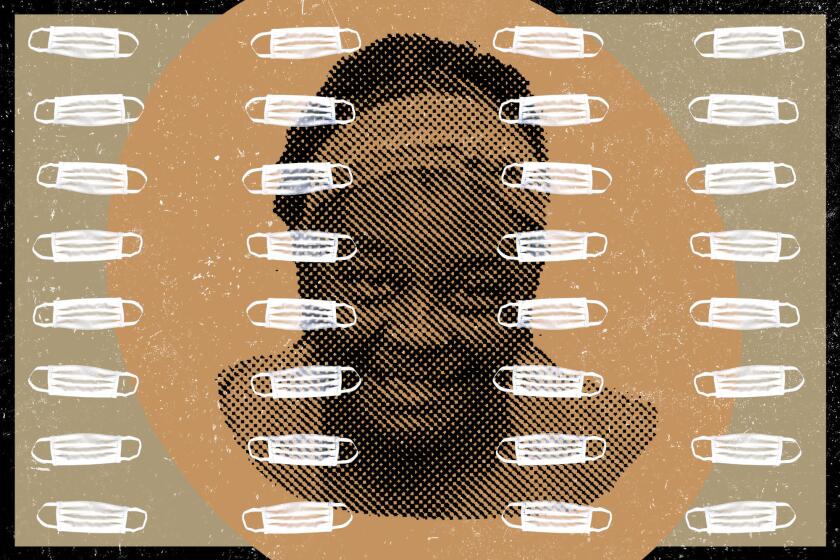Spy plane was sent to monitor protest in affluent suburb, home to head of California National Guard

- Share via
In early June, four National Guard spy planes took to the skies over several cities to monitor street protests following the killing of George Floyd, triggering concerns that the military was improperly gathering intelligence on U.S. citizens.
Three of the reconnaissance planes kept watch on demonstrations in Minneapolis, Phoenix and Washington, D.C., that drew hundreds or thousands of protesters and were marred by violence.
But the target of the fourth plane was far more surprising: the affluent Sacramento suburb of El Dorado Hills, the scene of much smaller and entirely peaceful protests.
Local and state authorities have not explained in detail how and why the normally sleepy neighborhood was chosen for the mission when other cities that had recently experienced property destruction and street clashes amid large protests — such as Los Angeles, Oakland and Long Beach — were not.
El Dorado Hills happened to be the home of the head of the California National Guard, Maj. Gen. David S. Baldwin, The Times has learned. In addition to deploying the RC-26B reconnaissance plane, the Guard sent a Lakota helicopter to hover over El Dorado Hills, according to Guard officials and records. The aircraft were requested by the El Dorado County Sheriff’s Office, state records show.
In response to questions from The Times, a spokesman for Gov. Gavin Newsom, who oversees the California National Guard, issued a statement late Saturday criticizing the operation.
In 11 shootings, including Kizzee’s, the bicyclists — all male and Black or Latino — were killed.
“The use of the RC-26 to meet the sheriff’s request for aerial support to provide situational awareness for law enforcement is concerning and should not have happened,” Nathan Click said. “It was an operational decision made without the approval — let alone awareness — of the governor. After the incident, operational policies and protocols were reaffirmed and strengthened to ensure RC-26 aircraft are not used for these incidents again.”
Click did not elaborate or say whether the governor’s office is examining Baldwin’s role in the matter.
In a telephone interview, Baldwin told The Times he didn’t recall whether he had approved the mission. He said the fact that he lived in El Dorado Hills had “nothing to do with” the deployment of the RC-26B or the Lakota helicopter.
After questions from Congress members and others about the flights, an Air Force inspector general’s report issued in August concluded that the reconnaissance planes weren’t capable of capturing “distinguishing personal features of individuals” and did not violate rules barring the military from collecting intelligence on U.S. citizens. The inspector general’s report did not include a detailed examination of whether the mission to El Dorado Hills was warranted given the uneventful nature of the protests.
The report states that the mission grew out of a “high priority” request by the state Office of Emergency Services, made on behalf of the El Dorado sheriff’s office. According to the report, the sheriff’s office said it needed the aircraft to provide support for deputies on the ground who were tracking demonstrations.
Baldwin, when asked why he couldn’t remember whether he recommended or approved the unusual use of a reconnaissance plane over his hometown, said “there was a lot going on” with protests up and down the state at that time.
The review follows a Times investigation that found some patients die while waiting months to see a specialist in the L.A. County public hospital system.
“We had 10,000 soldiers deployed,” he said. “We were doing hundreds of mission taskings.”
Under California’s open records law, The Times obtained the orders for the plane and helicopter, and they list Baldwin as the officer authorizing the deployments to El Dorado County. However, a Guard spokesman, Lt. Col. Jonathan Shiroma, said Baldwin’s name routinely appears on such orders, but his subordinates have the authority to assign the plane and helicopters to missions.
Baldwin said he never discussed the mission with Newsom and did not remember if he spoke about it with El Dorado County Sheriff John D’Agostini or whether he recommended that the sheriff’s office request the plane. Baldwin described his relationship with D’Agostini as “collegial” and similar to those he has with many sheriffs.
D’Agostini declined to be interviewed for this story. His spokesman did not answer the question of whether Baldwin advised the sheriff’s office to request the aircraft.
Five current and former Guard officers with knowledge of the flights said in interviews that they knew of no justifiable reason for the El Dorado Hills mission.
“El Dorado Hills was the most monitored place in California,” said Dan Woodside, a recently retired Guard pilot who has flown the RC-26B. “Why was that? What was the threat? They are absolutely covering this up.”
A current Guard officer, who asked not to be named because he is not authorized to speak about the mission, said, “We hear ‘El Dorado,’ and it’s, ‘What? What the hell is happening in El Dorado?’” He noted that officials did not request the plane for other areas that witnessed much larger protests, including some hit by vandalism and theft.
“Why aren’t we helping L.A., San Francisco, Oakland?” the officer asked. “It’s just buffoonery.”
Inmates who made masks and furniture for as little as 35 cents an hour say they felt pressure to stay on the job, even as the coronavirus spread through the prison factories.
A second former officer said enlisting the military to surveil demonstrators is a perennial “hot potato” among Guard leaders, and it was “idiotic” to send the RC-26B to El Dorado Hills. “It’s just bad optics,” said the ex-officer, who requested anonymity to protect current Guard members who informed him about the mission.
The Guard sent ground troops to El Dorado Hills and other California communities at the request of local authorities. The RC-26B, however, was used only over El Dorado Hills.
Witnesses told the inspector general’s office that the plane had not been used in the past to monitor civil disturbances, according to the report. The aircraft’s primary purpose is gathering intelligence on drug trafficking and helping to patrol U.S. borders. The plane is also summoned to chart the paths of wildfires and floods, and it is flown on search and rescue missions.
In June, the Army opened an investigation into complaints that National Guard helicopters, including the Lakota, flew dangerously low over crowds of protesters in Washington, D.C., allegedly in an attempt to intimidate the demonstrators. The Defense Department’s inspector general is now reviewing the findings of the inquiry, which have not been released, an Army spokesman said.
There were no reports of the Lakota flying low over the El Dorado Hills protesters.
The inquiry by the Air Force inspector general’s office into the deployment of the RC-26B aircraft to protests around the country concluded that its use skirted some Defense Department procedures but did not breach U.S. policy that generally bars the military from spying on U.S. citizens. The office’s report said the missions collected information on the size and movements of crowds and the destruction of property. The aircraft, however, were not equipped with surveillance technology that could identify individuals on the ground, the report says.
The document provides a narrative of the events, though key details — including names of officials who authorized the missions, as well as those who were involved — are redacted.
As the nationwide protests over Floyd’s death grew, Newsom declared a state of emergency on May 30 in Los Angeles County, on the basis that local law enforcement agencies could not deal with the threat posed by civil unrest. The declaration said nothing about El Dorado County, roughly 400 miles away.
Two days later, Asst. Chief Ron Quigley of the Office of Emergency Services submitted the request to the Guard for aerial monitoring in El Dorado County. The request cited “information of groups forming in the west end of El Dorado County,” the inspector general’s report said.
The inspector general’s office interviewed two people from the Guard’s 144th Fighter Wing at Fresno. One of them, a pilot at the base, received a phone call from the Guard’s Joint Force Headquarters in Sacramento with verbal orders to support the mission.
The RC-26B took off from the Air National Guard Base in Fresno shortly after 8 p.m. on June 3 for what was a roughly three-hour mission, with a stop at Sacramento County’s Mather Airport to pick up two law enforcement officers, according to the report.
Before the mission, the officers had received word that there were “rioters and looters planning to march to the suburbs of El Dorado County for violent purposes,” the inspector general’s report says.
It states that an El Dorado sheriff’s officer on the aircraft said the Hells Angels “may incite some violence around El Dorado Hills.” As the plane circled over the area, the crew spotted several police vehicles and foot patrols but no disturbances, according to the report.
The sheriff’s officers then determined that continuing the mission was unnecessary as “there did not appear to be any crowd activity of interest,” the report says. It was unclear if any protesters were on the streets at that time.
A Guard officer with knowledge of the flight told The Times that the crew “didn’t see anything. … It was a waste of time.”
Quigley, the OES administrator cited in the inspector general’s report, did not respond to an interview request The Times made through the agency’s spokesman, Brian Ferguson. In a statement, Ferguson said, “At the request of local leaders, in June, Cal OES facilitated the deployment of National Guard equipment and personnel to locations across the state to safeguard public safety and protect the well-being of the community and protestors alike.
“Use of the National Guard for law enforcement support is used only in extreme cases, or after the local government mutual aid system is fully committed.” The statement did not address whether the OES or the Guard considered the situation in El Dorado Hills to be an extreme case.
El Dorado County Supervisor John Hidahl, whose district includes most of El Dorado Hills, told The Times he heard several complaints that the sheriff’s and military response to a perceived threat of unrest was overkill. Hidahl said he did not have enough firsthand information to evaluate whether the show of force was warranted.
“The question is always: How significant is the threat?” Hidahl said. “I couldn’t say it was a high threat, but the sheriff definitely felt it was.”
He said he did not know Baldwin and wasn’t aware he lived in the area.
Caroline Cochrane, an activist from neighboring Folsom who attended multiple protests in surrounding areas to support the Black Lives Matter movement, called the National Guard’s presence in El Dorado Hills an “exploitation of resources” and a “response to fear-mongering.”
“It creates a very hostile environment, especially for African American residents,” said Cochrane, 17.
Steven Taylor, who specializes in civil liberties as an associate professor of government at American University in Washington, said the El Dorado Hills mission was “an expensive endeavor, and for what?”
“I don’t understand why they couldn’t just use black-and-whites there,” he said, referring to sheriff’s patrol cars. He added that the deployment of the aircraft “was just nonsensical unless it was used to intimidate people.”
More to Read
Sign up for Essential California
The most important California stories and recommendations in your inbox every morning.
You may occasionally receive promotional content from the Los Angeles Times.















